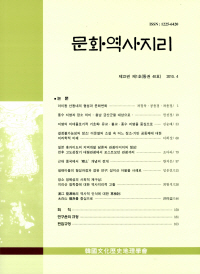- 영문명
- Ideological Signization of Place Names: A Case Study of Confucian/Buddhist/Fengshui Place Names
- 발행기관
- 한국문화역사지리학회
- 저자명
- 김순배(Sun-Bae Kim)
- 간행물 정보
- 『문화역사지리』제22권 제1호, 33~59쪽, 전체 27쪽
- 주제분류
- 사회과학 > 지리학
- 파일형태
- 발행일자
- 2010.04.30

국문 초록
지명의 지시와 구별 기능은 다양한 사회적 주체들의 아이덴티티와 이데올로기를 재현하고 구성하는 수준으로 확대되어, 지명의 의미와 의미 생산을 둘러싼 상이한 주체들 간의 갈등과 경합에 주목하는 문화정치로 연결되기도 한다. 본 논문이 지향한 문화정치적 지명 연구는 한국 지명의 생성과 변천 과정을 통해 사회적 주체가 지니고 있는 이데올로기가 재현되고 구성되는 과정을 분석하려는데 목적이 있다. 특히 문화연구와 함께 신문화지리학의 문화정치적 연구가 형성되는데 주요한 토대가 된 미하일 바흐찐과 미셸 페쇠의 언어이론을 적용하여 한국 지명의 이데올로기적 기호화 양상을 분석하였다. 구체적으로는 한국 지명의 이데올로기적 기호화 양상을 분석하기 위해 바흐찐의 이데올로기적 기호와 페쇠의 담론 이론이 지명 적용에 가능한지를 살펴보았다. 이를 통해 동일한 지명 유연성과 표기를 지닌 고유 지명이 그곳에 거주하는 상호 대립적인 사회적 주체의 특정한 이데올로기에 의해 다양하게 변화되어 차별적인 이데올로기적 기호로 바뀌는 과정이 포착되었다. 이러한 지명의 이데올로기적 기호화를 토대로 공주목 진관 구역에 소재하는 유고.불교.풍수 관련 지명들을 유형화하여, 지배적인 사회적 주체들에 의해 수행된 다양한 이데올로기적 지명화 사례들의 다양한 갈래와 특성을 분석하였다.
영문 초록
Place names could distinguish the self-places from the other-places, and indicate both of them. The indicating and distinguishing functions of place names could also be extended to the level which is to represent and constitute the identity and ideology of the diverse social subjects and groups. This aspect is related to the
cultural politics that is concerned with the conflicts and contestation among different social subjects over: the meaning and meaning production of place names. The aim of this article is to research the representing and constructing process of ideology which belongs to the certain social subjects through the formation and transformation of place names in Korea. Particularly, the language theories both referred by Mikhail Bakhtin and Michel Pêcheux, and based on the formation of cultural politics were applicable to the cases of ideological sign in Korean place names. First of all, for investigating the aspects of ideological sign in Korean place names, I examined that Bakhtin’s ideological sign and Pêcheux’s discourse theory are able to apply to the study of place names. And then, I significantly identified the various processes that the native place names has been transformed into the each different ideological signs by diverse social Subjects and groups‘ Last of all, classifying the place names in Gongju-Mok Jingwan. Area by ideological features, such as Confucianism, Buddhism and Fengshui, I analyzed the types and characteristics of naming the ideological place names which has been petformed by the dominant social subjects.
목차
1. 서 론
2. 지명의 이데올로기적 기호화
3. 유교 이데올로기적 지명화
4. 불교.풍수 이데올로기적 지명화
5. 결 론
해당간행물 수록 논문
참고문헌
최근 이용한 논문
교보eBook 첫 방문을 환영 합니다!

신규가입 혜택 지급이 완료 되었습니다.
바로 사용 가능한 교보e캐시 1,000원 (유효기간 7일)
지금 바로 교보eBook의 다양한 콘텐츠를 이용해 보세요!



